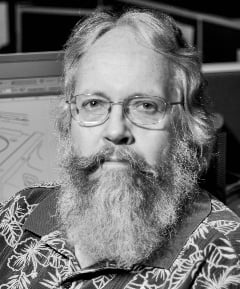
president of the Historical Society
of the Crescenta Valley and loves local history. Reach him at
lawlerdad@yahoo.com.
Finishing the series on the names of the peaks above CV, we turn towards the mountains around Mount Wilson. As you turn off Angeles Crest Highway onto Mount Wilson Road, you cross Red Box Saddle and drive past the Haramokngna American Indian Cultural Center. The mountain immediately above you is Mount Disappointment. It was named in 1875 by surveyors who, looking up at it from below, decided it was the highest peak in the group of peaks here and the perfect spot to use as a triangulation point. When they reached the summit, they were “disappointed” to find they were still looking up at San Gabriel Peak next door. The summit was further lowered in 1955 when it was graded flat for a Nike missile base.
The next peak in line is San Gabriel Peak, named in 1894 by the USGS for the Mission San Gabriel.
Continuing along Mount Wilson Road, we next encounter Mount Markham. Markham is the mountain that appears from Mount Wilson to be flat on top, and was previously named “Square Top.” It’s named for California governor Henry Markham (1891-95). During his tenure, Markham was no friend to the conservation of the San Gabriels, but he was rich and well connected, and so was honored with a peak named after him.
Occidental Peak looms up next before reaching Mount Wilson. It was first named The Knifeblade by naturalist John Muir after he climbed it in 1877, and it is still sometimes referred to as such. The Forest Service named it Occidental Peak in 1920 after a group of students from Occidental College constructed a trail there from Mount Wilson.
At the end of Mount Wilson Road is Mount Wilson itself, named for one of the most fascinating characters in California history, Benjamin Wilson. Wilson was one of the first Americans in Los Angeles, arriving here in 1841 as a fur trapper. He became a Mexican citizen and married into one of the land-rich rancho families. An ambitious man, he began acquiring huge tracts of real estate, later becoming involved in the Mexican-American War and the resulting statehood for California. He served as mayor of Los Angeles, and subdivided and developed the areas we know today as Pasadena, Alhambra, San Gabriel, Westwood, Riverside and San Bernardino. As a rancher and farmer, he raised sheep, grew fruit and nuts, and made wine commercially from his extensive vineyards. It was this last activity that led him to look upward to the heavily wooded unnamed mountain above his Pasadena home in 1864. Los Angeles was wood-poor, and Wilson needed barrels for his wine operations. Using an old Indian trail, he built a road up Mount Wilson to access the lumber. Although the lumber operations were a failure, the road was a big hit, and it became incredibly popular with hikers and campers in the late 1800s.
About this time, the civic boosters of Pasadena began agitating for an observatory to match the new Lick Observatory in San Jose. They approached Harvard’s observatory director William Pickering, who brought a portable telescope to Mount Wilson in 1889 and was blown away by the clarity of the atmosphere at the peak’s summit. Larger telescopes were built over the ensuing years, and Mount Wilson began to attract worldwide attention with the establishment of a 24-inch solar telescope, then a 60-inch reflector and, finally in 1917, the largest telescope in the world, the 100-inch Hooker Telescope. Famous astronomers such as Hale and Hubble here observed for the first time that there were galaxies beyond our Milky Way and that the universe was expanding, leading to the formulation of the Big Bang Theory. The observatory is still a leader in stellar research, and recently produced the first photographs of the surface of a star outside our solar system. The observatory has a wonderful guided tour and museum, and makes a great destination after a long drive up the mountain.
I hope you enjoyed this series on the names of the San Gabriel Mountain features above us. I hope to do the same for the Verdugo Mountains soon.
